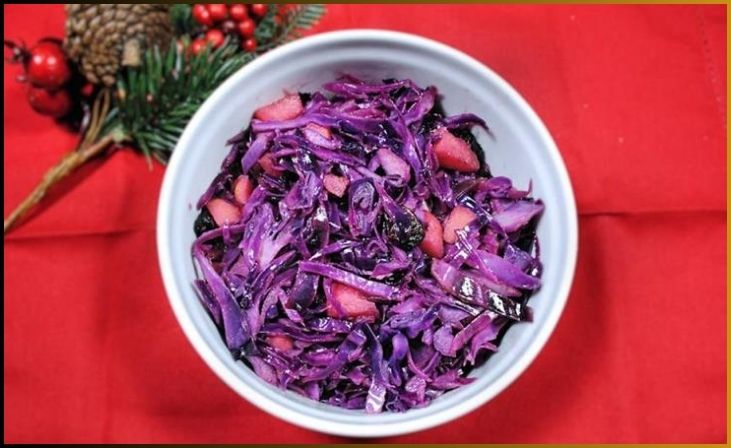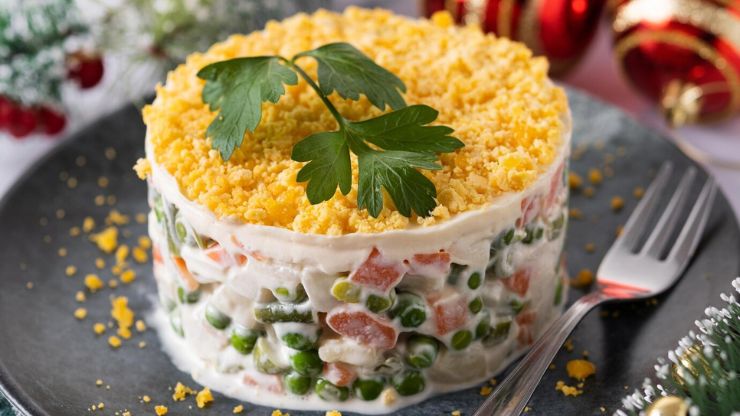The holiday season is a time of joy, celebration, and indulgence. It’s a season where the aroma of delicious meals wafts through the air, filling our homes with warmth and anticipation. And while many holiday dishes take center stage, there’s something to be said about a humble yet transformative side dish that can elevate any meal – sauerkraut. In this blog, we’re introducing you to a festive twist on the classic sauerkraut recipe: Christmas Kraut.
Sauerkraut, with its zesty and tangy flavor, is an excellent addition to your holiday spread. It not only provides a refreshing contrast to rich and hearty dishes but also boasts numerous health benefits. Making sauerkraut at home is a straightforward process, and with a few extra ingredients, you can create a Christmas-inspired version that’s perfect for your holiday feasts.
Table of Contents
ToggleThe Charm of Sauerkraut
Before we delve into our Christmas Kraut recipe, let’s explore the charm of sauerkraut itself. Sauerkraut, a German term that means “sour cabbage,” is a fermented cabbage dish that dates back centuries. The preparation process involves naturally fermenting shredded cabbage through lactic acid bacteria, resulting in its characteristic tangy flavor and numerous health benefits.
Why Sauerkraut is a Gem:
- Rich in Probiotics: Sauerkraut is a probiotic powerhouse. It’s packed with beneficial bacteria that support gut health, boost the immune system, and promote overall well-being.
- Vitamin C: Cabbage, the main ingredient in sauerkraut, is a fantastic source of vitamin C, which is essential for maintaining a strong immune system.
- Easy to Make: Making sauerkraut at home is a simple and rewarding process that requires minimal ingredients and equipment.
Also Read- Recipe for Salted Preserved Lemons
Christmas Kraut Recipe
Christmas Kraut is a festive adaptation of traditional sauerkraut that adds holiday flavors to this classic side dish. With the addition of seasonal ingredients like cranberries, apples, and a touch of warming spices, Christmas Kraut becomes a delightful and colorful addition to your holiday table.
Ingredients for Christmas Kraut:
- 1 medium-sized green cabbage
- 2-3 apples, cored and thinly sliced
- 1 cup fresh cranberries
- 2 tablespoons sea salt
- 1 teaspoon caraway seeds
- 1 teaspoon ground cinnamon
- 1/2 teaspoon ground nutmeg
Making Christmas Kraut

Let’s get started with creating this flavorful and festive side dish:
1. Prepare the Cabbage
Preparing the cabbage is the first step in creating Christmas Kraut, a festive variation of sauerkraut. To begin, select a medium-sized green cabbage, ensuring it’s fresh and free from any blemishes. Start by removing the outer leaves and setting them aside for later use. These outer leaves will play a crucial role in keeping the sauerkraut submerged during fermentation.
Then, slice the cabbage into thin strips. You can choose to do this by hand using a sharp knife or make the process more efficient with a food processor. Slicing the cabbage finely allows it to absorb the flavors and spices more effectively during the fermentation process. The cabbage serves as the primary ingredient, providing the sauerkraut with its signature texture and tangy taste, and it sets the stage for the festive ingredients that will be added to create Christmas Kraut.
2. Season the Cabbage

After slicing the cabbage into thin strips, it’s time to season it to create the foundation for Christmas Kraut. In a large bowl, combine the sliced cabbage with the other key ingredients. This includes the addition of 2-3 cored and thinly sliced apples, which will infuse the sauerkraut with a delightful sweetness and a touch of tartness. To enhance the festive flavors, add a cup of fresh cranberries, bringing a burst of color and a tangy note. To aid the fermentation process and develop the characteristic sauerkraut flavor, add 2 tablespoons of sea salt.
As a final touch, include spices such as caraway seeds, ground cinnamon, and ground nutmeg. These spices contribute warmth and depth to the sauerkraut, giving it that special Christmas touch. Mixing all these ingredients together ensures that the cabbage is evenly coated with the spices, salt, and additional components, creating the perfect base for your Christmas Kraut.
3. Massage the Ingredients
Once you’ve combined the cabbage, apples, cranberries, salt, and spices in a large bowl, the next step in creating Christmas Kraut is to gently massage the ingredients. Using clean hands, carefully knead and squeeze the mixture. This process serves several important purposes.
First, massaging the ingredients encourages the cabbage to release moisture. The salt draws out this natural cabbage juice, which, in turn, creates a brine. This brine is essential for the fermentation process, as it submerges the cabbage mixture and allows the lactic acid bacteria to thrive, resulting in the tangy flavor of sauerkraut.
Don't just scroll, subscribe!
BuzzTrail's unique web-stories are the cure for boredom you've been waiting for.
Second, massaging ensures that all the ingredients are thoroughly mixed and evenly coated with the spices and salt. This even distribution is key to achieving consistent flavor throughout the Christmas Kraut.
4. Pack into a Jar

With your Christmas Kraut mixture thoroughly massaged and brimming with flavor, the next step is to pack it into a clean glass jar. This step is essential for ensuring that your sauerkraut ferments correctly and retains its delicious qualities.
Before you start packing the sauerkraut into the jar, reserve the outer cabbage leaves you set aside earlier. These leaves will play a vital role in the fermentation process by helping to keep the sauerkraut submerged in the brine.
Begin by placing the reserved outer cabbage leaves at the bottom of the clean glass jar. These leaves act as a natural barrier, preventing the sauerkraut from floating to the surface during fermentation.
5. Fermentation
Once you’ve tightly packed your Christmas Kraut mixture into a glass jar, the magic of fermentation begins. Fermentation is the heart of sauerkraut creation and is what gives it that signature tangy flavor. During this process, natural lactic acid bacteria work their transformative wonders, turning the cabbage, apples, cranberries, and spices into a delicious and probiotic-rich dish.
To initiate fermentation, seal the jar with a tight-fitting lid. Then, place the sealed jar in a cool, dark spot. The ideal temperature for sauerkraut fermentation is around 60-70°F (15-21°C). This allows the lactic acid bacteria to thrive and transform the ingredients.
Over the next one to two weeks, the sauerkraut will undergo remarkable changes. You may notice bubbles forming in the jar; this is a sign that fermentation is underway. As the days pass, the cabbage, apples, and cranberries will continue to soften, and their flavors will meld, creating the distinctive taste of Christmas Kraut.
6. Taste and Enjoy
After patiently allowing your Christmas Kraut to ferment for about one to two weeks, it’s time to savor the fruits of your labor. The journey from slicing cabbage and adding festive ingredients to the magic of fermentation has transformed these simple components into a flavorful and probiotic-rich delicacy.
To taste and enjoy your Christmas Kraut, open the jar and use a clean fork or spoon to take a small sample. Pay attention to its texture, flavor, and level of tanginess. Fermentation is a personal preference, so sample your sauerkraut periodically to determine when it has reached your desired taste.
Once you’re satisfied with the flavor, it’s time to move the jar to the refrigerator. The cool environment will slow down the fermentation process, preserving the sauerkraut’s texture and taste at their peak. Now, your Christmas Kraut is ready to be served alongside your holiday dishes.
Christmas Kraut Serving Tips
Serving Christmas Kraut is a delightful experience that can enhance your holiday meals. Here are some serving tips to make the most of this festive sauerkraut:
- Traditional Side Dish: Serve Christmas Kraut as a classic side dish alongside roasted meats like turkey, ham, or pork. Its tangy and slightly sweet flavors complement the richness of holiday fare.
- Colorful Garnish: Use Christmas Kraut as a colorful and flavorful garnish for various dishes. Sprinkle it on top of salads, sandwiches, or even as a vibrant topping for grilled sausages.
- Festive Relish: Turn Christmas Kraut into a festive relish for your holiday table. It pairs beautifully with cheese platters, and charcuterie boards, and as a condiment for sandwiches and sliders.
- Vegetarian Delight: For vegetarian or vegan guests, Christmas Kraut can be the star of the show. Incorporate it into meatless dishes as a flavorful and probiotic-rich component.
- Recipe Enhancement: Elevate your favorite holiday recipes by adding a spoonful of Christmas Kraut. Whether it’s mixed into stuffing, stirred into soups, or used as a topping for casseroles, it can enhance the overall flavor profile.
- Creative Appetizers: Get creative with Christmas Kraut by using it as a key ingredient in appetizers. Create sauerkraut crostinis with goat cheese, incorporate it into savory tarts, or make sauerkraut and cheese-stuffed mushrooms for unique starters.
For More- How to Make No-Salt Kimchi Recipe
Bottom Line
In the spirit of the holiday season, Christmas Kraut brings a touch of festive flair to your table, elevating the classic sauerkraut to new heights. Its tangy, slightly sweet, and spiced profile is a delightful accompaniment to your holiday feasts, offering both flavor and health benefits. Christmas Kraut is a culinary gift to your taste buds and a celebration of the art of fermentation.
As you share this flavorful sauerkraut with your loved ones, you’re not only spreading the joy of the season but also embracing a culinary tradition that has been cherished for generations. The process of making Christmas Kraut is a testament to the magic of fermentation and the transformative power of food.
FAQs
How long does Christmas Kraut last in the refrigerator?
How long does Christmas Kraut last in the refrigerator?
Christmas Kraut can last for several weeks in the refrigerator when stored properly. Its flavor may continue to develop over time.
Can I customize the spices in Christmas Kraut to suit my taste?
Can I customize the spices in Christmas Kraut to suit my taste?
Absolutely, feel free to adjust the spices to your liking. Experiment with different spices like cloves, allspice, or ginger to create a unique flavor profile.
Can I use red cabbage for a more colorful Christmas Kraut?
Can I use red cabbage for a more colorful Christmas Kraut?
Red cabbage can be used alongside green cabbage for a vibrant and colorful twist on Christmas Kraut.
Is Christmas Kraut suitable for vegetarians and vegans?
Is Christmas Kraut suitable for vegetarians and vegans?
Yes, Christmas Kraut is a vegetarian and vegan-friendly dish that can be enjoyed by a wide range of dietary preferences.

